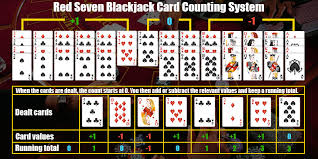
The Red 7 card counting-system is known to be very simple to learn, yet powerful enough to provide professional-level efficiency.
It was developed by blackjack guru Arnold Snyder and released in his book Blackbelt in Blackjack in 1983.
How it works
You definitely need to know basic blackjack strategy, because this system does take into consideration strategic moves at times.
In many other systems, running count is the determining factor on when to raise or lower your bet. With Red 7, running count and elements of blackjack strategy are combined to make informed decisions.
There are only 3 card values: -1, 0 or +1 and your count continues until there is a shuffle, but your count will not always start at zero.
It is an unbalanced system (meaning if you were to count down a deck, you would not end at zero) and your starting count will depend on the number of decks being used. That is known as the Initial Running Count or IRC.
The IRC with this system is figured at:
- One deck – starting count is -2
- Two decks – starting count is -4
- Four decks – starting count is -8
- Six decks – starting count is -12
- Eight decks – starting count is -16
The IRC formula for those starting counts is the number of decks x 2 and then make it negative. Easy to remember.
Because this adjustment is made to start, there is no need for a true count, making it an easier system to implement, because of no necessary dividing.
The card value chart is:
| 2 | 3 | 4 | 5 | 6 | red7/black7 | 8 | 9 | 10 | J | Q | K | A |
| +1 | +1 | +1 | +1 | +1 | +1/0 | 0 | 0 | -1 | -1 | -1 | -1 | -1 |
While the thought of having to keep track of the color of 7’s that drop may seem scary, it will easily become second nature with a little practice.
As with all counting systems, the higher the count, the more you should bet.
Sizing your bets
The most common sizing with this system, is to use the running count as a multiplier. For example, if the running count is +4, your bet should be 4 times the table minimum. Conversely, if the running count is +1 or less, your bet should remain the table minimum.
Another way to size your bet is by tiers. For instance, if your running count is +2 to +3, you’d bet 2 times the minimum. If it’s +4 – +5, you’d bet 3 times the minimum. You can determine the specific tier to choose, plus the multiplier, but you want keep it moderate. Tier sizing is not as aggressive and therefore less detectable by the casino.
Snyder, the developer of the system, suggests that you can multiply your bet by 2 when the running count is 0. Depending on the number of decks in play, that multiplier will increase as the count gets higher. You can find his suggested chart here.
The general idea is to bet enough, with the advantage, to cover the cost of the smaller minimum bets or “waiting bets.”
The method you choose to size your bet should totally be determined by what fits your individual needs. Using a system is beneficial in that it will keep your wins and losses to maximums and minimums, while misdirecting the fact that you’re counting cards.
Using blackjack strategy with Red 7 count
You first have to understand the pivot point. This is the point, in card counting, when the deck becomes favorable to the player. With most systems that start with a zero count, the pivot point is +3, +4 or +5.
Basically, because the count starts at a negative number with this system, the pivot point is at +1, once into positive territory. The deck must become very favorable (a bunch of low cards must be dealt) before the pivot point is reached, with this system, leaving little chance to be fooled by a temporary swing of the cards.
Additional strategies to work with:
- If the running count is 0 or higher, stand with 16 against a dealer 10
- If the running count is 0 or higher, stand with 12 against a dealer 3
- If the running count is +2 or higher, stand with 15 against a dealer 10
- If the running count is +2 or higher, stand with a 12 against a dealer 2
- If the running count is +2 of higher, double down on a 10 total against a dealer ace
- In 1 or 2 deck game, if the running count is 0 or higher, take insurance
- In a shoe game, if the running count is +2 or higher, take insurance
If you know basic strategy, the above moves are against basic strategy, but the knowledge that there are more high cards at those times, changes the strategy.
Final Thoughts
The Red 7 Count system is another easy card counting system to learn that is great for beginners. While it has factors that require knowledge of basic strategy, it shouldn’t deter you from learning it. All card counting systems work best with basic strategy knowledge.




